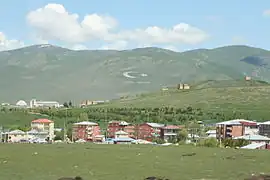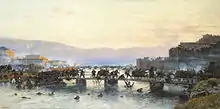Ardahan
Ardahan (Georgian: არტაანი, romanized: art'aani;[2] Armenian: Արդահան, romanized: Ardahan;[3] Kurdish: Erdêxan[4]) is a city in northeastern Turkey, near the Georgian border. It is the seat of Ardahan Province and Ardahan District.[5] Its population is 22,927 (2021).[1]
Ardahan | |
|---|---|
 | |
 Ardahan Location in Turkey | |
| Coordinates: 41°06′40″N 42°42′08″E | |
| Country | Turkey |
| Province | Ardahan |
| District | Ardahan |
| Government | |
| • Mayor | Faruk Demir (CHP) |
| Elevation | 1,811 m (5,942 ft) |
| Population (2021)[1] | 22,927 |
| Time zone | TRT (UTC+3) |
| Postal code | 75000 |
| Website | www |
History
Ancient and medieval
Ardahan was historically located in the region of Gogarene (Gugark), which Strabo calls a part of the Armenia that was taken away from the Kingdom of Iberia.[6][7] In the Middle Ages Ardahan served as an important transit point for goods arriving from the Abbasid Caliphate and departing to the regions around the Black Sea. During the 8th to 10th centuries the region was in hands of the Bagrationi princes of Tao-Klarjeti under the name of Artaani, and later part of Kingdom of Georgia between 11th to 15th centuries. According to the Arab historian Yahya of Antioch, the Byzantines razed Ardahan and slaughtered its population in 1021.[7]
The Mongols took hold of the city in the 1230s but the Georgian princes of Samtskhe were able to recapture it in 1266. In 1555, by the Peace of Amasya, the western part of the principality of Samtskhe was annexed by the Ottoman Empire,[8] and Ardahan was included into the sanjak of Ardahan (an overall part of the vilayet of Akhaltsikhe). The Ottomans turned Ardahan into a formidable fortress-town. In the 1640s the Ottoman traveler Evliya Çelebi visited Ardahan and gave the following description: "The fortress of Ardahan sits atop an inaccessible cliff. It is square-shaped and sturdy... This fortress has a cold climate and, because of this, there are no gardens or orchards. Fruits arrive from the fortress at Ajara and Tortum."[9]
Modern

Aleksey Kivshenko.
Before 1829 Ardahan was recorded to have had 400 households, the majority of them Armenian.[7] Many of them later emigrated to the Russian Empire in the early 19th century. During the Russo-Turkish War (1828–1829) it was an important road junction connecting the border fortress of Akhaltsikhe to the Kars-Erzerum road. The town passed into the hands of Russia following the 1877-1878 Russo-Turkish War and was made a part of the Ardahan Okrug of the Kars Oblast. The majority of the town was made up of Armenians, while other ethnic groups included Georgians, Pontic Greeks (here usually called Caucasus Greeks), Caucasus Jews, Russians, Kurds, Ossetians, and Yazidis.[7] A Polish community was also established, with the majority of Poles being sent to Ardahan from the Russian Partition of Poland after being conscripted to the Russian Army.[10] The town flourished economically under Russian rule, exporting fruits, smoked lamb meat, wheat and wood. New roads were constructed, linking Ardahan to Akhalkalak, Kars, and Oltu. On 25 December 1914, in the early months of the First World War, the Ottoman Army occupied Ardahan and massacred many of its Armenians, Pontic Greeks, and Georgians. The Russians, with the help of Armenian and Pontic Greek militias, captured the town on January 3, 1915, allowing some of the original inhabitants who had fled to return.

As Russian forces withdrew from the front following the October Revolution, a small Armenian volunteer force took up positions to defend the town from the approaching Ottoman Army. On March 6, 1918, the Ottoman army, along with the help of the town's Muslims, overwhelmed Ardahan's Armenian garrison and retook the town. Ardahan was occupied by [11]Democratic Republic of Georgia in 20 April 1919. When the Turkish Nationalists captured Ardahan in 23 February 1921,[12] the town's remaining Armenians, Pontic Greeks, and Georgians fled to Armenia, northern Greece, and Georgia. The Treaty of Moscow, signed the following year between the Soviets and the Ankara Government, confirmed Ardahan as a part of Turkish territory.
In 1986 a brief description of the fortress was published.[13] The original late antique/medieval walls of Ardahan Kalesi were extensively rebuilt several times and in the 19th they were adapted to accommodate small cannons.
In 1960, Ardahan's population stood at 7,228 and was populated by both Kurds and Turks.[7]
Demographics
| Year | Total | Ethnic groups |
|---|---|---|
| 1886[14] | 778 | Turks 403 (51.8%), Russians 172 (22.1%), Armenians 141 (18.1%), Greeks 48 (6.2%), Kurds 7 (0.9%) |
| 1897[15] | 4,142 | Russians 1,331 (32.1%), Armenians 1,315 (31.7%), Turks 746 (18%), Poles 206 (5%) |
| 1916[16] | 3,167 | Armenians 1,708 (53.9%), Sunni Muslims 778 (24.6%), Roma 361 (11.4%), Russians 270 (8.5%) |
| 1960[17] | 7,228 | |
| 1970[17] | 13,399 | |
| 1980[17] | 14,912 | |
| 1990[18] | 16,761 | |
| 2000[17] | 17,274 | |
| 2010[17] | 16,251 |
Geography
Ardahan is situated in northeastern Turkey, close to the border with Georgia. It lies on the upper course of the river Kura, south of the Yalnızçam Mountains. The town consists of 7 quarters: Halilefendi, Karagöl, Kaptanpaşa, Yenimahalle, Gürçayir, Atatürk and Inönü.[19]
Climate
Ardahan has a humid continental climate (Köppen: Dfb, Trewartha: Dc), bordering on a subarctic climate (Köppen: Dfc, Trewartha: Ec) on higher elevations, with brief, mild summers and very cold winters.
Summers are mild to warm during daytime, but turn colder nocturnally. Because of this, temperatures below freezing have been recorded every month of the year. It is also frequently rainy most of the year, especially in spring and summer.
Winters are quite snowy with snow cover lasting from late October to mid April. Although it does snow in September and May, accumulating snowfall is rare. On rarer occasions, it has also snowed in summer months, such as the snowfall in August 2013. The highest recorded snow thickness was 113 cm (44.5 inches) on 30 January 1968.
| Climate data for Ardahan (1991–2020, extremes 1958–2020) | |||||||||||||
|---|---|---|---|---|---|---|---|---|---|---|---|---|---|
| Month | Jan | Feb | Mar | Apr | May | Jun | Jul | Aug | Sep | Oct | Nov | Dec | Year |
| Record high °C (°F) | 11.1 (52.0) |
11.0 (51.8) |
18.4 (65.1) |
25.0 (77.0) |
28.9 (84.0) |
33.1 (91.6) |
34.3 (93.7) |
35.0 (95.0) |
32.1 (89.8) |
26.0 (78.8) |
18.7 (65.7) |
14.3 (57.7) |
35.0 (95.0) |
| Average high °C (°F) | −4.4 (24.1) |
−2.7 (27.1) |
3.6 (38.5) |
11.1 (52.0) |
16.4 (61.5) |
20.8 (69.4) |
24.3 (75.7) |
25.2 (77.4) |
21.2 (70.2) |
15.2 (59.4) |
6.7 (44.1) |
−1.5 (29.3) |
11.3 (52.3) |
| Daily mean °C (°F) | −10.3 (13.5) |
−9.1 (15.6) |
−2.3 (27.9) |
4.7 (40.5) |
9.6 (49.3) |
13.3 (55.9) |
16.4 (61.5) |
16.7 (62.1) |
12.5 (54.5) |
7.2 (45.0) |
−0.1 (31.8) |
−7.3 (18.9) |
4.3 (39.7) |
| Average low °C (°F) | −15.5 (4.1) |
−14.6 (5.7) |
−7.5 (18.5) |
−0.8 (30.6) |
3.6 (38.5) |
6.5 (43.7) |
9.4 (48.9) |
9.3 (48.7) |
4.9 (40.8) |
0.7 (33.3) |
−5.4 (22.3) |
−12.1 (10.2) |
−1.8 (28.8) |
| Record low °C (°F) | −39.8 (−39.6) |
−38.7 (−37.7) |
−33.2 (−27.8) |
−19.0 (−2.2) |
−8.5 (16.7) |
−4.5 (23.9) |
−2.2 (28.0) |
−2.8 (27.0) |
−5.8 (21.6) |
−15.0 (5.0) |
−28.9 (−20.0) |
−36.3 (−33.3) |
−39.8 (−39.6) |
| Average precipitation mm (inches) | 24.0 (0.94) |
21.7 (0.85) |
37.0 (1.46) |
54.2 (2.13) |
85.2 (3.35) |
101.7 (4.00) |
77.2 (3.04) |
64.8 (2.55) |
38.9 (1.53) |
41.1 (1.62) |
29.9 (1.18) |
24.7 (0.97) |
600.4 (23.64) |
| Average precipitation days | 7.80 | 7.97 | 10.33 | 14.23 | 17.97 | 15.50 | 12.97 | 12.00 | 9.47 | 10.87 | 7.93 | 8.03 | 135.1 |
| Mean monthly sunshine hours | 80.6 | 104.5 | 155.0 | 153.0 | 195.3 | 234.0 | 257.3 | 251.1 | 213.0 | 164.3 | 111.0 | 77.5 | 1,996.6 |
| Mean daily sunshine hours | 2.6 | 3.7 | 5.0 | 5.1 | 6.3 | 7.8 | 8.3 | 8.1 | 7.1 | 5.3 | 3.7 | 2.5 | 5.5 |
| Source: Turkish State Meteorological Service[20] | |||||||||||||
Notable locals
- See Category:People from Ardahan
References
- "Address-based population registration system (ADNKS) results dated 31 December 2021" (XLS) (in Turkish). TÜİK. Retrieved 12 January 2023.
- "არტაანი" (in Georgian). National Parliamentary Library of Georgia. Retrieved 5 July 2020.
- Թորոսյան, Շիրակ. "Արդահանի հարցը հայ-վրացական հարաբերություններում և խնդրի ժամանակավոր լուծումը (1919 թ. մայիս-դեկտեմբեր)" (PDF). Yerevan State University: 1.
{{cite journal}}: Cite journal requires|journal=(help) - "Erdêxan". Ria Taza (in Kurdish). Retrieved 5 July 2020.
- İl Belediyesi, Turkey Civil Administration Departments Inventory. Retrieved 12 January 2023.
- Strabo. Geographica. 11.14.7 Archived 1 February 2014 at the Wayback Machine.
- (in Armenian) "Ardahan," Armenian Soviet Encyclopedia. Yerevan: Armenian Academy of Sciences, 1976, vol. 2, p. 7.
- Mikaberidze, Alexander (2015). Historical Dictionary of Georgia (2 ed.). Rowman & Littlefield. p. xxxi. ISBN 978-1442241466.
- (in Armenian) Evliya Çelebi. Turkakan Aghbyurner, Evlia Chelebi [Turkish Sources, Evliya Chelebi], trans. and commentary by A. Kh. Safrastian. Part of the Series on Foreign Sources on Armenia and Armenians: Turkish Sources, vol. 3. (Yerevan: Haykakan SSH Gitutyunneri Akademiayi Hratarakchutyun, 1967), p. 113.
- Chodubski, Andrzej (2009). "O Polakach w Armenii i Azerbejdżanie w XIX i na początku XX wieku". Studia Polonijne (in Polish). Lublin. 30: 132, 138. ISSN 0137-5210.
- https://dergipark.org.tr/en/download/article-file/884723 The Fight of Dominaton in Ardahan According to Turkish, Georgian and Armenian Historians (Turkish Article) Page 1235
- https://dergipark.org.tr/en/download/article-file/884723 The Fight of Dominaton in Ardahan According to Turkish, Georgian and Armenian Historians (Turkish Article) Page 1241
- Robert W. Edwards, "The Fortifications of Artvin: A Second Preliminary Report on the Marchlands of Northeast Turkey," Dumbarton Oaks Papers 40, 1986, pp.176-78, pls. 44-45.
- Şimşek, Oğuz. "Türkiye Cumhuriyeti'nin İlk Genel Nüfus Sayımında Ardahan Vilâyeti'nin Nüfus Özellikleri" (in Turkish): 209.
{{cite journal}}: Cite journal requires|journal=(help) - Первая всеобщая перепись населения Российской Империи 1897 г. Распределение населения по родному языку и уездам Российской Империи кроме губерний Европейской России (in Russian). Demoscope Weekly. Retrieved 8 April 2014.
- Кавказский календарь на 1917 год [Caucasian calendar for 1917] (in Russian) (72nd ed.). Tiflis: Tipografiya kantselyarii Ye.I.V. na Kavkaze, kazenny dom. 1917. pp. 198–201. Archived from the original on 4 November 2021.
- "Ardahan: Nüfus Bilgileri" (in Turkish). Belediyeler Konuşuyor. Archived from the original on 17 April 2014. Retrieved 17 April 2014.
- "Ardahan'ın Tarihçesi" (in Turkish). Ardahan Ticaret İl Müdürlüğü. Retrieved 17 April 2014.
Kentin 1990 yılı nüfusu 16,761'dir.
- Mahalle, Turkey Civil Administration Departments Inventory. Retrieved 16 January 2023.
- "Resmi İstatistikler: İllerimize Ait Mevism Normalleri (1991–2020)" (in Turkish). Turkish State Meteorological Service. Retrieved 11 April 2021.
External links
Further reading
- (in Armenian) Kyureghyan, Levon. Կարս և Արտահան (Kars and Artahan). Vienna: Mkhitarian Press, 1949.
- (in Armenian) Yeremyan, Suren T. Հայաստանը ըստ «Աշխարհացույցի» (Armenia According to the Ashkharatsuyts). Yerevan: Armenian Academy of Sciences, 1963.